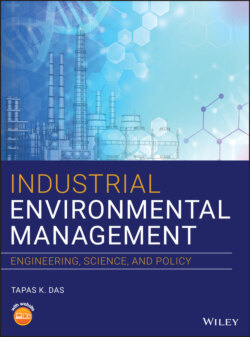Читать книгу Industrial Environmental Management - Tapas K. Das - Страница 19
1.2.1 Environmental Challenges
ОглавлениеOur avid interest in environmental sustainability and environmental management issues can be traced directly to awareness that as the world's population continues to expand and to consume natural resources, humanity faces shortages that threaten quality of life in developed areas and elsewhere on the Earth, life itself. In attempts to find solutions to these problems, we have created an ever growing inventory of manufactured goods, chemicals, drugs, ostensibly to improve the quality of life that has in fact contributed to the pollution of our environment. “Pollution prevention,” an environmental buzz word since the 1990s, encompasses designing processes that generate no waste to plants that emit only harmless compounds such as pure water.
Zero defect and zero effect (ZDZE) is different from pollution prevention in that it converts raw materials into useful products or valuable resources that have “no defect” in manufactured products and “zero effect” has no adverse effect on health and environment. In this book, the meanings of “Zero Effect,” “Zero Discharge,” or “Zero Emissions” are complimentary and all terms are used interchangeably (Das 2005). Within the ZDZE paradigm the goal of resource extraction, refining, or commodity production is approached in much the same way that the mining, iron and steel, pulp and paper, petroleum, energy, automobiles, petrochemical, pharmaceutical, fertilizer, agricultural, and chemical industries go about processing raw materials. Sometimes the conversion of wastes or by‐products into resources having value to another industry is more efficient than the implementation of pollution prevention techniques – that is industrial ecology (also see Chapter 9).
In this book, we will focus on the best management practices, best available industrial manufacturing processes, techniques, and technologies that treat raw materials into no‐defect products, as well as innovative and emerging processes that have best potential for achieving the highest standards in pollution prevention at the plant and industry levels, leading to no defect and zero effect (NDZE) – a common goal toward industrial environmental management. To move toward NDZE via process pollution prevention (P3) and profitable pollution prevention (P3), industries must use processes that deploy materials and energy efficiently enough to neutralize and control contaminants in the waste stream. The ultimate goal is to remove pollutants from the waste streams and convert them into products or feeds for other processes. Logically then, P3 refers to industrial manufacturing processes by which materials and energy are efficiently utilized to achieve the end product(s) that have “no defect,” while reducing or eliminating the creation of pollutants or waste at the source that is “zero discharge or zero effect.” The primary goal is to educate the engineering students to prepare them as current and future generation engineers who will learn and practice sustainable engineering and who will be our champion stewards in industrial environmental management as needed caretakers of the Earth.
